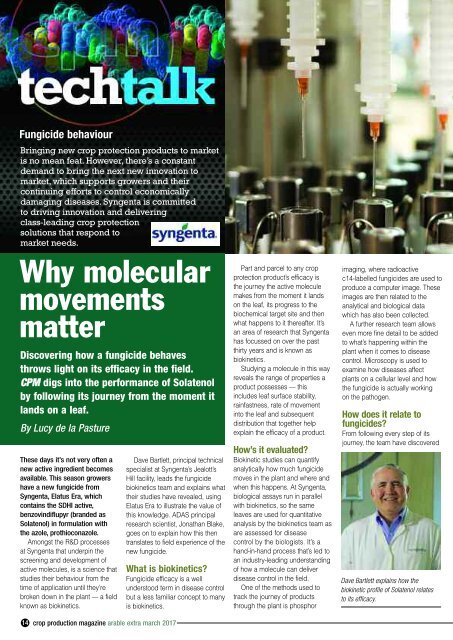In this issue..
CPM-March-Extra-2017
CPM-March-Extra-2017
Create successful ePaper yourself
Turn your PDF publications into a flip-book with our unique Google optimized e-Paper software.
Fungicide behaviour<br />
Bringing new crop protection products to market<br />
is no mean feat. However, there’s a constant<br />
demand to bring the next new innovation to<br />
market, which supports growers and their<br />
continuing efforts to control economically<br />
damaging diseases. Syngenta is committed<br />
to driving innovation and delivering<br />
class-leading crop protection<br />
solutions that respond to<br />
market needs.<br />
Why molecular<br />
movements<br />
matter<br />
Discovering how a fungicide behaves<br />
throws light on its efficacy in the field.<br />
CPM digs into the performance of Solatenol<br />
by following its journey from the moment it<br />
lands on a leaf.<br />
By Lucy de la Pasture<br />
These days it’s not very often a<br />
new active ingredient becomes<br />
available. This season growers<br />
have a new fungicide from<br />
Syngenta, Elatus Era, which<br />
contains the SDHI active,<br />
benzovindiflupyr (branded as<br />
Solatenol) in formulation with<br />
the azole, prothioconazole.<br />
Amongst the R&D processes<br />
at Syngenta that underpin the<br />
screening and development of<br />
active molecules, is a science that<br />
studies their behaviour from the<br />
time of application until they’re<br />
broken down in the plant –– a field<br />
known as biokinetics.<br />
Dave Bartlett, principal technical<br />
specialist at Syngenta’s Jealott’s<br />
Hill facility, leads the fungicide<br />
biokinetics team and explains what<br />
their studies have revealed, using<br />
Elatus Era to illustrate the value of<br />
<strong>this</strong> knowledge. ADAS principal<br />
research scientist, Jonathan Blake,<br />
goes on to explain how <strong>this</strong> then<br />
translates to field experience of the<br />
new fungicide.<br />
What is biokinetics?<br />
Fungicide efficacy is a well<br />
understood term in disease control<br />
but a less familiar concept to many<br />
is biokinetics.<br />
14 crop production magazine arable extra march 2017<br />
Part and parcel to any crop<br />
protection product’s efficacy is<br />
the journey the active molecule<br />
makes from the moment it lands<br />
on the leaf, its progress to the<br />
biochemical target site and then<br />
what happens to it thereafter. It’s<br />
an area of research that Syngenta<br />
has focussed on over the past<br />
thirty years and is known as<br />
biokinetics.<br />
Studying a molecule in <strong>this</strong> way<br />
reveals the range of properties a<br />
product possesses –– <strong>this</strong><br />
includes leaf surface stability,<br />
rainfastness, rate of movement<br />
into the leaf and subsequent<br />
distribution that together help<br />
explain the efficacy of a product.<br />
How’s it evaluated?<br />
Biokinetic studies can quantify<br />
analytically how much fungicide<br />
moves in the plant and where and<br />
when <strong>this</strong> happens. At Syngenta,<br />
biological assays run in parallel<br />
with biokinetics, so the same<br />
leaves are used for quantitative<br />
analysis by the biokinetics team as<br />
are assessed for disease<br />
control by the biologists. It’s a<br />
hand-in-hand process that’s led to<br />
an industry-leading understanding<br />
of how a molecule can deliver<br />
disease control in the field.<br />
One of the methods used to<br />
track the journey of products<br />
through the plant is phosphor<br />
imaging, where radioactive<br />
c14-labelled fungicides are used to<br />
produce a computer image. These<br />
images are then related to the<br />
analytical and biological data<br />
which has also been collected.<br />
A further research team allows<br />
even more fine detail to be added<br />
to what’s happening within the<br />
plant when it comes to disease<br />
control. Microscopy is used to<br />
examine how diseases affect<br />
plants on a cellular level and how<br />
the fungicide is actually working<br />
on the pathogen.<br />
How does it relate to<br />
fungicides?<br />
From following every step of its<br />
journey, the team have discovered<br />
Dave Bartlett explains how the<br />
biokinetic profile of Solatenol relates<br />
to its efficacy.


